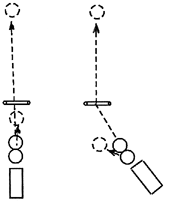
|
Back to |
| The Front Page |
| The Game |
|
Coaching the Fundamentals of the Stroke Part Four: Peels without Hoops by John Riches, Australian Correspondent Posted September 11, 1997
|
| |||||||||
It seems a dubious proposition - actually removing the hoop to practise a peel. But the author is, after all, the most highly accredited croquet coach in the world, and this is the advice he gives to the coaches he trains. So perhaps it will work for you, as well.
Someone once commented to me that the game of croquet would be so much easier if there were no hoops. There is more truth in this statement than one may suspect, since in addition to the problems of making hoops, balls hitting them at the wrong time, and having them hamper our strokes, there are situations in which the presence of a hoop can have a strong psychological effect. This is especially noticeable when peeling, and is one of the factors which a player must learn to cope with in order to triple peel consistently.
 The diagram above shows red about to peel yellow through its hoop
(say, penultimate) and at the same time get a rush on blue (to 2-back).
In order to find the correct line of swing for this shot, it is
necessary to imagine that the hoop is not there, and to choose an aiming
point halfway between where you estimate the two balls would then finish.
The diagram above shows red about to peel yellow through its hoop
(say, penultimate) and at the same time get a rush on blue (to 2-back).
In order to find the correct line of swing for this shot, it is
necessary to imagine that the hoop is not there, and to choose an aiming
point halfway between where you estimate the two balls would then finish.
However, there is a strong psychological tendency to want to ensure that the red ball misses the hoop by swinging the mallet in the direction in which you want the red ball to travel. This will in fact cause the red ball to go well out to the right, with no chance of obtaining the desired rush. The correct way to play the shot is best learnt by practising it with the hoop removed, then replacing the hoop and simply ignoring its presence, as should be done with all peels once the shot has been lined up.
The left hand diagram below shows red peeling yellow through the rover hoop, using a stop-shot in which the red ball remains in front of rover and can make the hoop on the following shot. Here, also, the presence of the hoop seems to create an illusion that the shot can be played with less "stop" than is actually needed. Players tend to underestimate the stop ratio required, which is often about 6:1, near enough to the maximum possible.
There is also the knowledge that the peeled ball must go far enough through the hoop to allow red to make the hoop without roqueting it (if the player wishes to complete his turn by pegging out both balls); and the fact that the yellow ball has to pass through the hoop seems to cause most players to hit the shot harder than necessary, and harder than they would if the hoop were not there. They then find it difficult to understand why the red ball is over-running the hoop.
 Again, the shot should be practised with the hoop removed in order to
establish the correct way to play it. This psychological difficulty is also
a reason why many players prefer to peel rover with an "Irish Peel",
sending both balls through the hoop in the one stroke.
Again, the shot should be practised with the hoop removed in order to
establish the correct way to play it. This psychological difficulty is also
a reason why many players prefer to peel rover with an "Irish Peel",
sending both balls through the hoop in the one stroke.
If the peel has to be made at a slight angle, as illustrated in the right-hand diagram, then an "Irish Peel would be more difficult, and if the stop-shot peel is used, the psychological effect of the hoop is even greater because angled hoop shots generally need to be hit harder than straight ones. The fact that the yellow ball is now less directly in front of the red ball is just another complicating factor, and once again the shot should be first practised without the hoop.
E-Mail: John.Riches@Adelaide.on.net